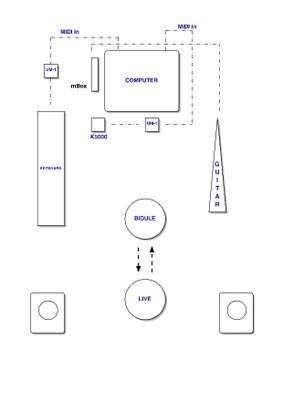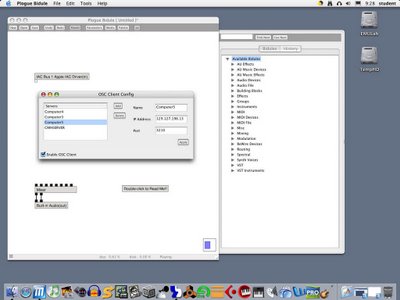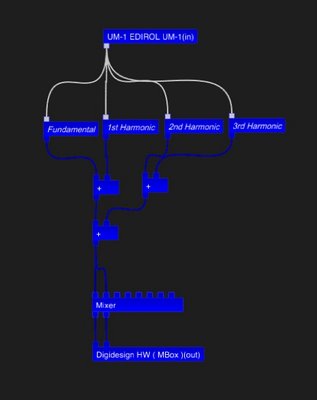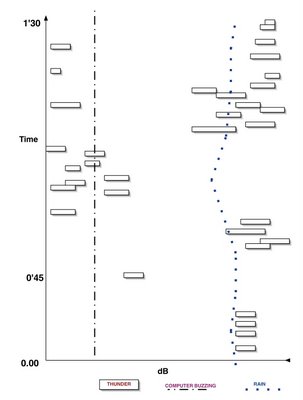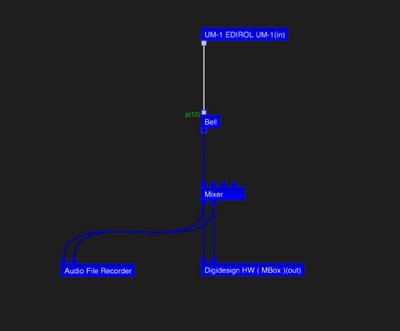Workshop -Improvisation-
Our final session at uni this year was the workshop. This session was a great way to finish off the year. I performed in the second group and I was on the Juno 6 synth. At the beginning of our performance I couldn't hear myself but luckily Ben increase my level on the mixer and away I was creating my awesome arpeggios and filter sweeps.
I had fun but I thought each group may have played too long. Maybe I was just really tired or maybe I was just waiting to finally go home and sleep!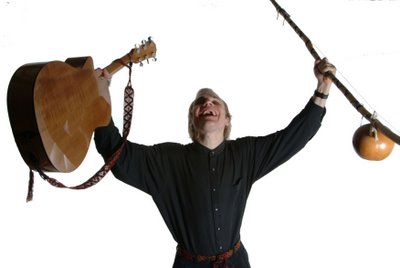
Saturday, November 18, 2006
Creative Computing Major Assignment
For my major assignment this semester I had to compose an electronic piece and perform the piece in real time. I created my sounds in Plogue Bidule and used Live also to trigger off my samples. Bidule ran as the master in this case.
In Bidule I created a number of patches. Below is my piano pad sounds I made.
This is my PolySynth patch.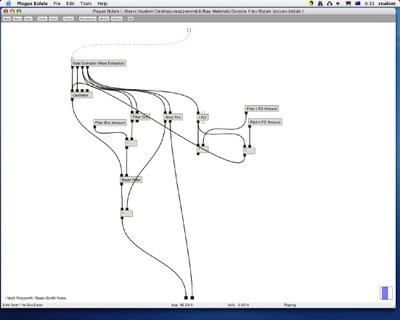
This is my Multi-Synth patch.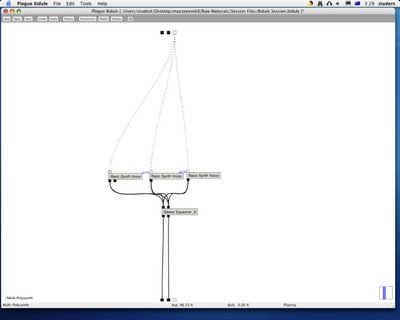
This is my Bidule Session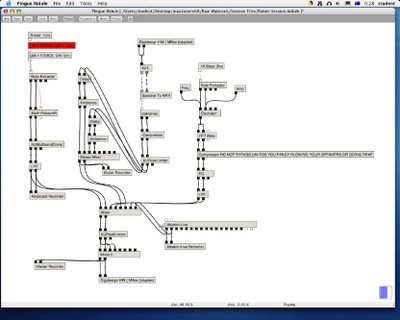
I created my bass patch using spectral processing. This created a large amount of stress on the CPU usage. The sound was very loud which I was able to fix with a compressor. You can see the compressor in my Bidule session. 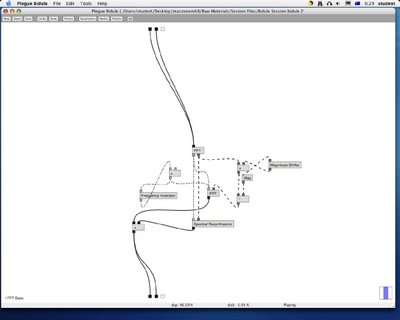
My guitar sound was created by controlling a VSTi. The guitar audio was converted to MIDI using a spectral Bidule. After the plugin, the signal runs through two delays and two ambient plugins.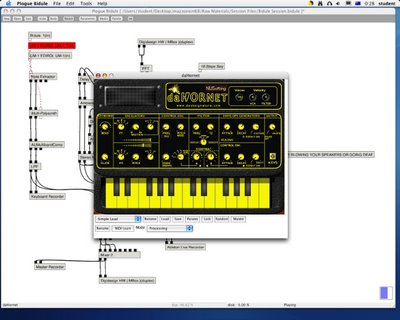
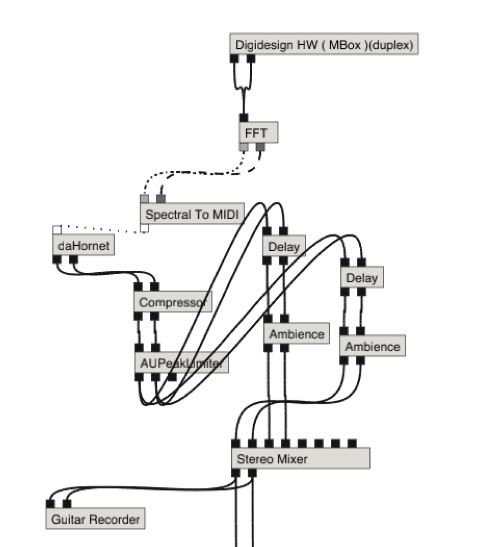
My Live session had four scenes (the maximum allowable in Lite Edition). 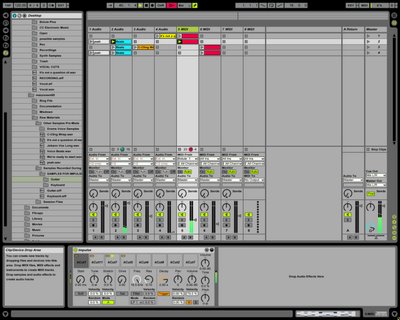
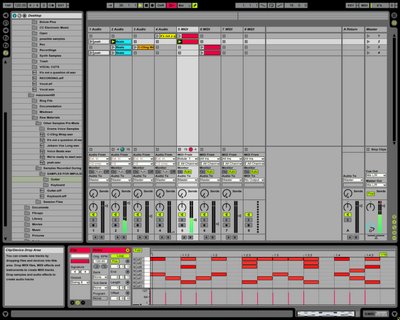
I have a recording of my live set.
Crazy Piani High Quality [8.5MB]
Crazy Piani Medium Quality [5.7MB]
Crazy Piani Low Quality [2.5MB]
I also have my documentation attached if you want to read.
My Documentation + Samples
Audio Arts Minor Environment Assignment
This semester, I chose to do my Audio Arts as my minor. The assignment was to record a sound scape using a portable recorder. I used the Maranz Firewire recorder instead of the DAT.
We then had to recreate the sound scape by identifying all the sounds, mapping them in a sound event map, recreating them, and then doing a 5.1 surround mix in Cubase. All the sounds had to be created using synthesis or sampling techniques. If we used a sample it had to be a basic sound. In my case I used a recording of paper being blown into.
All my synthesised sounds were created in Plogue Bidule. I recorded my Bidule patches and then imported the audio files into Cubase. I have some pictures of my Bidule patches and my Cubase Session. I also have a stereo mix of my sound scape and recreation.
AA_Minor High Quality (4.5MB)
AA_Minor Low Quality (1.3MB)
Original Soundscape (2.7MB)
Documentation
This is a screenshot of my final result.

These are the patches for my bird sound.

Week 13 Forum [1]
[1]
Today we had guest speaker Johannes Sistermanns. He is an artist from Germany who does Sound Plastic.
During the presentation Johannes claimed that he practiced sound plastic and not sound installations. I don’t understand the difference. I’m not sure if it’s because his English wasn’t the best or if it’s because I just don’t understand what he does. There’s one thing I know for sure, and that is he seems to love cling wrap.  [2]
[2]
Unfortunately he didn’t have any audio to play to us, which I though was a bit strange. It’s pretty difficult to imagine what tons and tons of cling wrap will sound like. I imagine like a gigantic sandwich. As you can see it’s the end of the year and I just want to get this blog finished. [3]
Here are some samples that to make the Johannes experience come alive.
Sample 1 (44KB)
Sample 2 (128KB)
[1] Johannes Sistermanns. "Johannes Sistermanns", http://www.st.rim.or.jp/~mal/Cafe/JSS3.jpg (Accessed November 11th 2006)
[2] Johannes Sistermanns. "Johannes Sistermanns", http://www.rachelhaferkamp.de/images/sistermanns/sister06pics/Gang_DeckeBoden_.jpg (Accessed November 11th 2006)
[3] Johannes Sistermanns. 'Music Technology Forum Presentation - EMU Space'. Lecture presented in the EMU Space, Electronic Music Unit, University of Adelaide, 2nd November 2006.
Week 12 Forum
Today was another improvisation session. David Harris spent some time with us. He was trying to get a 7/8 rhythm going. Seeing as though I struggle with any timing other than 4/4, this was a challenge. After a while I got the hang of it. David played some chords on the piano, which help keep us all together.
I think this improvisation session was not up to scratch like the other weeks. Seeing as though it was just before exam time I think everyone was stressed.
Friday, November 17, 2006
Week 12 Creative Computing
This week I started using the K5000 to control parameters in Bidule. This was really useful. Ben showed me a really quick way of linking the parameters in Bidule to the knobs on the K5000. I utilised this controller a lot in my assignments as it gives you a lot more control and a mouse.
Week 11 Forum
Today we had guest speaker Luke Harrold. It was nice to have a guest speaker for a change. I was lucky to have Luke as my theory lecturer in Certificate IV. I had no idea at the time he was doing a PHD in Music Technology.
He spoke to us about his research overseas. He was in Paris attending this major event called NIME, which stands for “new interfaces for musical expression”. I am going to Paris in December so I might check this out. That’s if my family don’t get too bored.
The best part of Luke’s presentation was a movie he showed us of a live Japanese performer Adachi Tomomi. He had all these senses attached to different parts of his body in such a way that movement would set them off. He was creating music using his body movements. Well I don’t know if you can call it music. The actual sound got annoying after a while. The idea though was really interesting and I can definitely see this concept being used in many avenues of entertainment in the future. [1] [2] Finger movements
[2] Finger movements
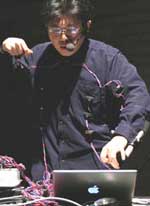 [3] Good to see him using a real computer.
[3] Good to see him using a real computer.
[1] Luke Harrold. 'Music Technology Forum Presentation - EMU Space'. Lecture presented in the EMU Space, Electronic Music Unit, University of Adelaide, 19th October 2006.
[2] Dream Train Internet. “Adachi Tomomi?”, http://www.purple.dti.ne.jp/naya/contens/img/adachi3-2web.jpg (Accessed 11th November 2006)
[3] Dream Train Internet. “Adachi Tomomi?”, http://www.h5.dion.ne.jp/~olounge/ido062/062photo/adachi.jpg
(Accessed 11th November 2006)
Week 11 Audio Arts
This week we had to created a doppler effect. This wasn't too hard. Once again, sorry for the small picture.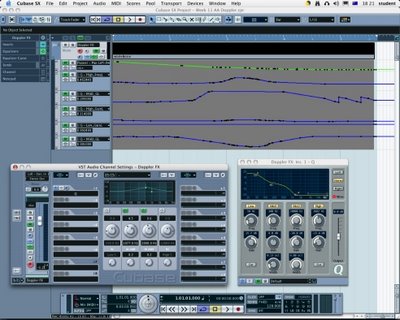
Doppler Effect [221KB]
Week 10 Forum
Today’s forum was guess what... Improvisation. I though that an entire two hours of improvisation would have dragged on a bit. Turns out we pull some great sounds. I was on the Juno synth and I selected my sounds on the MIDI sound module in the rack (of Studio 5). I wish I could select my sounds quicker without having to always refer to the sound module. Still, the sounds are quite good.
I do prefer playing off a computer because I can control the parameters of the synthesisers in real time. The synths in Reason are better to use because I can shape the sound and change patches really easily.
The improvisation session was good my only criticism is the dodgy speakers in Studio 5. There’s no bass!
Week 10 Creative Computing
This week I have to rewire Bidule and Reason together. The picture is really small and I don't know how to fix it. Sorry.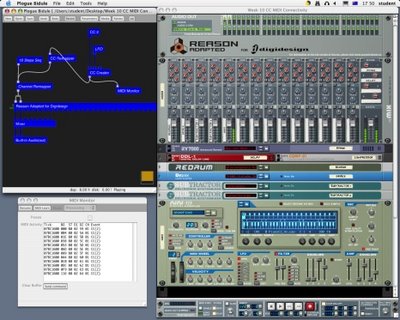
Bidule & Reason Connectivity [312KB]
Week 10 - AA - Spectral Water
This is my water sound using spectral processing in Bidule. I think the end result sounds okay.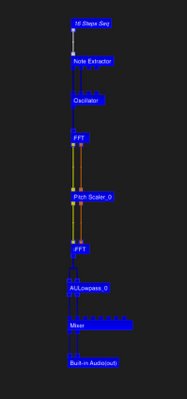
Water Sound [280KB]
Week 9 Forum - Improvisation Group 3
Today was my week for the improvisation session. And what a session it was. I was luckily enough to improvise with Tyson Hopprich or better known as DJ Tr!p. This two hour session was my highlight of the year for me. Being a DJ myself, it was really great to be able to talk to DJ Tr!p about the industry and the music he is producing and has produced. Who knows, maybe in 10 years I will be taking an improvisation session!
I got there early to check out the setup and have a chat to DJ Tr!p. He was using a CD turntable connected to a DJ mixer and also a laptop running Fruity Loops. He also had a Gameboy Advanced connected to one of the inputs of the mixer. The Gameboy had a Gamboy Camera attached to it. He was incorporating the basic 8-bit sounds from the Gameboy into his mixing.
When everyone arrived he gave an awesome demo. He mixed the drum loops from Fruity Loops to the beats from his Gameboy. My “trained” ear could hear when the beats were slightly going out of time but DJ Tr!p was quick to correct them. He also scratched some samples using the CD turntable.
I have never seen this kind of experimentation before in DJs, and I really want to start doing this myself. I have a Gameboy Advanced at home so don’t be surprised if you catch me in a club pulling out some Super Mario tunes!
Our improvisation session went awesomely (is that a word?). I was on the piano and my plan of attack was to first figure out was key we were in. Then I would play the chords and play any note I think sounded good (I suppose that’s what improvisation is anyway). We did three takes and they all sounded pretty good. I swapped with Dragos on the last take and I was on the Juno Synth. I actually found this harder to perform with because my sound didn’t go with everyone else and I didn’t have time to flick through patches. Still I just had fun watching DJ Tr!p do his thang.
Overall today was just awesome and I really hope we have this kind of exposure in future forums. [1]
[1] The Awesome DJ Tr!p. 'Music Technology Forum Improvisation Session - EMU Space'. Lecture presented in the EMU Space, Electronic Music Unit, University of Adelaide, 21th September 2006.
Saturday, November 11, 2006
Week 8 Forum - Improvisation Group 2
Today we had our second group do their improvisation session. Our guest today was Dr. Chandrakant Sardeshmukh (we should call him Dr. Sard for short). I though this improvisation session was really amazing. I loved the music and by the end of the session I was lying on the floor in a semi-sleep state. That wasn't because I found the music boring. In fact, it was quite the opposite. I found the music really relaxing and I could have easily fallen asleep. I think I did for a short time.
When the music ended I wanted it to go for longer and I wish someone recorded this improvisation session. One thing that the doc showed us which I though was really interesting was his scales. In India the major scale is in fact what we would call the Lydian mode. So the forth is raised. I thought that it was interesting to see how different cultures have different scales. I didn't learn modes till this year so prior to that I assumed that the major scale as we know it is prominent in all music. How wrong I was.
You could tell that Dr. Chandrakant Sardeshmukh was enjoying himself and it was great to see how passionate he was about his music. I really enjoyed this improvisation session. I just wish we had something comfortable to sit on, on the floor!
[1] Dr. Chandrakant Sardeshmukh. 'Music Technology Forum Improvisation Session - EMU Space'. Lecture presented in the EMU Space, Electronic Music Unit, University of Adelaide, 14th September 2006.
[2] Darshanam. " Dr. Chandrakant Sardeshmukh", http://www.darshanam.com/images/prof2.jpg (Accessed 11th November 2006)
Week 8 Creative Computing
This is the sound work I created using Live and Bidule in rewire mode. Bidule is master application in this situation. This was a very quick collaboration of sounds but I think it has potential to sound good if i spent more time on it.
The synth sound is from Bidule using a patch that I created. The drum sounds are from Impulse in Live. The other loops are from Live too. 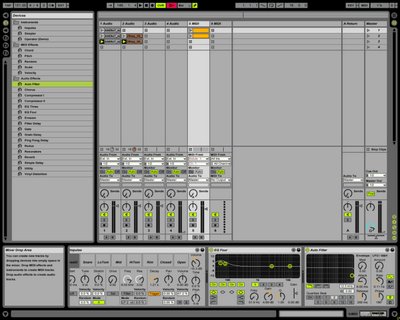
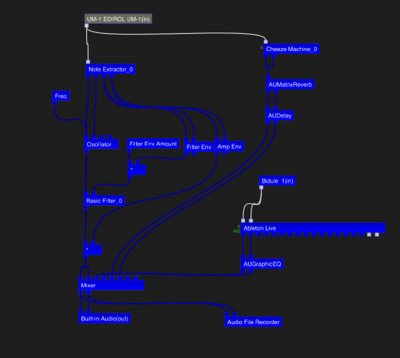
Bidule & Live Jam [4.3MB]
Week 7 Forum - Improvisation Group 1
Today we had a guest speaker and improviser Derek Pascoe. I really liked his perspectives on his music and life in general. I thought he sounded very professional in the way he spoke and he seemed to know what he was talking about.
Today the first improvisation group played. So, I guess, after all these weeks now was the time to see where it was all going. The improvisation session was very unusual. There wasn't any real order. Everyone just seemed to play all the time and I don't think they really knew when to play or not. Derek's playing of his saxophone reminded me of fusion jazz. He played a lot of arpeggios and it sounded pretty good. I think that everyone in the group needed to listen to what each other were doing so they could work with the sounds better. Still though it was a good experience and I think the session went well. 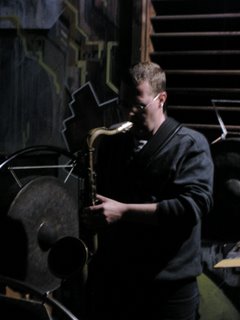
[1] Derek Pascoe. 'Music Technology Forum Improvisation Session - EMU Space'. Lecture presented in the EMU Space, Electronic Music Unit, University of Adelaide, 7th September 2006.
Week 7 Audio Arts
This is my attempt of creating a bell sound. It sounds okay but could be better if I spent more time. 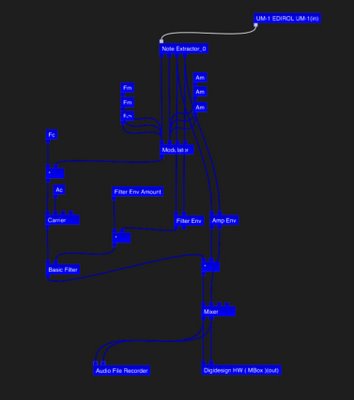
Bell Sound [172KB]
Monday, October 16, 2006
Week 6 Forum
Our improvisation session today went reasonably well. I didn’t arrive until 2.00pm, when the class started, but some enthusiasts had arrived earlier and where already making some music. I improvised on the keyboard today and I think I am going to keep that up. Mainly because I am comfortable with the piano and I know how to improvise with it. 
[1]
I still think feel that this whole improvisation idea is dragging on a bit too long. We need more variety in our forum rather than doing the same every week. By the end of the semester it won’t be improvisation anymore because we are just going to continue what we’ve been doing beforehand.
Our presenters today were Tyrell, Poppi, Josh and Albert. Tyrell was first and he played some music he composed for a video game company. When I presented my music I played some music I was writing for a video game company. It is the same company. I thought Tyrell’s music was very suited for a game and I think his orchestration was really good despite what he thought. The music he wrote for the kids game was really good too. One of the pieces that Tyrell played reminded me of the game Unreal Tournament. [2]
Poppi was next and she played some short movies she had done music and sound for. I thought these clips were very artistic and I was impressed at her work. There was a variety of music using found sounds and her voice. Great work. [3]
Josh was next and he played his musique concrete piece, i.e. Creative Computing from semester one. I thought the piece sounded very metallic with lots of modulation. It was very interesting. I can’t really comment on whether it was good or not because to me all musique concrete pieces sound the same. [4]
Finally Albert played us a jazz recording. I thought it sounded really good but that’s probably because I love the genre. The recording attributes were great. Nice work. [5]
[1] Vividest World. ‘Music Hall’, Vinkeys. http://www.geocities.co.jp/MusicHall/6548/jpg/asr.jpg (Accessed 16th October 2006)
[2] Tyrell Blackburn. 'Music Technology Forum Presentation - EMU Space'. Lecture presented in the EMU Space, Electronic Music Unit, University of Adelaide, 31st August 2006.
[3] Poppi Doser. 'Music Technology Forum Presentation - EMU Space'. Lecture presented in the EMU Space, Electronic Music Unit, University of Adelaide, 31st August 2006.
[4] Josh Schulz. 'Music Technology Forum Presentation - EMU Space'. Lecture presented in the EMU Space, Electronic Music Unit, University of Adelaide, 31st August 2006.
[5] Albert Webster. 'Music Technology Forum Presentation - EMU Space'. Lecture presented in the EMU Space, Electronic Music Unit, University of Adelaide, 31st August 2006.
Saturday, October 14, 2006
Week 6 Creative Computing
This is the Bidule patch I created. I looked at some websites to get help as to how to make a synth. I still haven't got to the stage where I can create one without any help. 

mp3_of_this_patch 296KB
Week 6 Audio Arts
This is the final bounce mp3 file of my Video exercise. I have also attached the movie links incase you would like to see the movie and sound together.
Movie_Sound_Track 793KB
I utlised my paper sounds plus some created in Reason. I found that creating sounds in Reason was harder than manipulating pre-recorded sounds.
The lower quality movies don't sound as good, obviously, and not all the sounds can be heard like in the higher quality movies.
Super_High_Quality 16.7MB
High_Quality 8.7MB
Medium_Quality 1.1MB
Low_Quality 464KB
I also have a couple of screen shots of the process.
Half_way_through
Finished_product
Monday, October 09, 2006
Week 5 Forum
Today our improvisation was slightly better than previous weeks. I still didn't have an instrument to play as I decided to scrap the idea of turntablism due to the fact that I would need to bring in my own DJ mixer. I don't really want to do this as one of my DJ mixers hardly works, and the other one that does work costs an arm and a leg. 

[1] This lead to me experimenting with the Theremin for a bit, which annoyed everyone in the group, especially Ben. I played around on one of the synthesisers for
a bit and produced some interesting sounds, but really I don't feel our group has any kind of direction yet as to how we are going to perform later in the semester. [2]
To top everything off the fire alarm went off in the first 10 minutes of our sessions so really we only had about half an hour to do anything today. I really hope the next few weeks go better.
Our presenters for this week were Tim, Ben, Jake, and Will. Tim started off playing a tape piece he did in first year. Since then the course has changed so I haven't done this assignment. I have spliced tape before in my SAE course. I am glad we no longer do this in the degree because it is just a headache.
The sounds that Tim was able to create and manipulate were quite interesting. It didn't really sound like much of a composition but I still thought the overall sounds were interesting. [3]
Tim played a jazz recording also. I really enjoyed this recording, but that might be just because I love jazz. The production techniques were top notch. Excellent job Tim! [4]
Jake was next to play his piece. He played his Creative Computing piece, which was a musique concrete piece. His original assignment was mixed in 5.1 Surround Sound. I would really like to hear what it sounds like in surround. The stereo version, which is what we heard in forum, was still very good. It sounded quite scary actually and I think this production would be perfect for a movie or video game. Great job Jake! [5]
Ben was next and he played his Creative Computing piece from first semester. What was really interesting about Ben’s piece was that it was created using sounds created entirely by his own voice. He showed us some sample recordings of his voice that were pitched down and slowed down. These sounded really cool. I think his musique concrete piece sounded pretty good and there was a lot of variation despite only using one instrument. I especially liked the ending how it ended with a long vocal yell and then modulated in an effect. Awesome stuff! [6]
Will also played us his Creative Computing piece, a musique concrete piece. This piece, I thought, was very cinematic. It reminded me of a sci-fi movie or video game, which is what I think Will was trying to do. This piece sounded awesome. Great work! [7]
[1] Allen & Heath. ‘DJ mixers’, Allen & Heath. http://www.allen-heath.com/ahimages/hi_res/xone62_front_angled.jpg (Accessed 14th October 2006)
[2] Electronic Music Unit. ‘Studio 5’, http://www.emu.adelaide.edu.au/images/facilities/studio.3.jpg (Accessed 14th October 2006)
[3] Tape Center. ‘Yahoo’ http://lib.store.yahoo.net/lib/tapecenter/reel-reel-large.JPG (Accessed 14th October 2006)
[4] Tim Gabbusch. 'Music Technology Forum Presentation - EMU Space'. Lecture presented in the EMU Space, Electronic Music Unit, University of Adelaide, 24th August 2006.
5] Jake Morris. 'Music Technology Forum Presentation - EMU Space'. Lecture presented in the EMU Space, Electronic Music Unit, University of Adelaide, 24th August 2006.
[6] Ben Probert. 'Music Technology Forum Presentation - EMU Space'. Lecture presented in the EMU Space, Electronic Music Unit, University of Adelaide, 24th August 2006.
[7] Will Revill. 'Music Technology Forum Presentation - EMU Space'. Lecture presented in the EMU Space, Electronic Music Unit, University of Adelaide, 24th August 2006.
Week 5 Creative Computing
This is my first Bidule patch I created. The sound isn't particually great but I still need to get used to creating synths in Bidule. 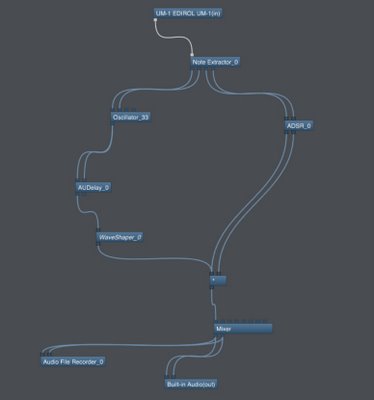
Patch_mp3
Week 5 Audio Arts
This is the piano sound I created using Reason's Subtractor. I found this exercise really difficult. I think my end up result sounds like a piano but probably more so like a piano pad sound. I have an attached mp3 as an example and also a screen shot of Reason.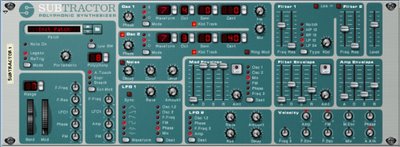
Piano_Example
Saturday, September 02, 2006
Week 4 Forum
Our improvisation session for this week did not run as smoothly as anticipated. Still, it was better than last week. My turntables had disappeared so I had to find another instrument. This time I experimented with the Theremin and one of the synthesisers. The Theremin eventually became very annoying, as Ben will confirm. The keyboard allowed for a wider variety of sounds. [1]
I found that the Theremin created a whining sound and that was really all it did. Today was still a headache when trying to route everything into the mixer. We did get some kind of jam session going but we still need to do more work. Jake had some nice drumbeats going and David was playing some nice riffs.
Today the presentations were Henry, Daniel and myself. Henry was first to play his piece called Lucky. He played his Creative Computing assignment, which was an electronic piece he composed in SuperCollider. This piece was dedicated to his grandfather, a photographer in WW2, to express and remember his life. I thought that Henry portrayed this idea very well. My favourite part of the whole piece was the photograph sound at the very end. To me this symbolised a “Polaroid” of the sounds cape. Henry created some really nice, interest ding sounds and I liked the piece overall. [2]
Daniel played us a Heavy Metal recording of his called If when you say heaven you mean the gates of hell. I can’t remember if this was his Audio Arts assignment, or if it was just a recording he did in his own time. I thought the recording was well produced and I didn’t notice any glitches. Although Daniel did point out that he wanted to fix some of the drum and bass sounds. [3]
This week it was my turn to play some music and I chose to play my own music rather than my assignments. I did this because my assignments were rushed and I didn’t like them at all. Also, I don’t think that my assignments show what kind of music I can create well. I played three pieces and I forgot to tell the class what the names of the tracks were. The first piece was a clip I wrote for a video game company who I am currently doing contract work for. The second piece was a drum ‘n’ bass track I whipped up the morning before Creative Computing that morning. The final piece was an electronic piece I composed as an assignment for my SAE course. If anyone is interested, the names of the tracks were:
1) Running
2) Untitled
3) Rain
The track Running is a working progress, which I would like to finish in the near future. It is currently attached to the prototype of an RPG game for Silhouette Studios. The final piece Rain was played on Fresh FM 92.7 a couple of weeks ago and is currently on the station’s playlist. So anyone who listens to that station look out for the track Rain by Matt Reverie (my alias producer name).
[1] Electronic Music Unit. ‘Studio 5’, http://www.emu.adelaide.edu.au/images/facilities/studio.3.jpg (Accessed 9th October 2006)
[2] Henry Reed. 'Music Technology Forum Presentation - EMU Space'. Lecture presented in the EMU Space, Electronic Music Unit, University of Adelaide, 17th August 2006.
[3] Daniel Murtagh. 'Music Technology Forum Presentation - EMU Space'. Lecture presented in the EMU Space, Electronic Music Unit, University of Adelaide, 17th August 2006.
CC - Week 4 - Performance Sequencing
This week we used Live again. We explored the other session view. This week I made a drum n bass track using samples again. The one effect I used was a filter which you can hear on the drums half way through the piece. There is a problem of distortion which ordinarily I would fix but putting a compressor on the ambient track.
Week_4_Live_DNB_Sequence
**This file is 4.7MB**
Week 4 Audio Arts
This is my final result for the Cubase Sound Track. I am utilising my paper sounds plus some created in Reason. I found that creating sounds in Reason was harder than manipulating pre-recorded sounds.
The lower quality movies don't sound as good, obviously, and not all the sounds can be heard like in the higher quality movies.
Super_High_Quality 16.7MB
High_Quality 8.7MB
Medium_Quality 1.1MB
Low_Quality 464KB
I also have a couple of screen shots of the process.
Half_way_through
Finished_product
Week 3 Forum
Today we were back in Studio 5 for our improvisation. I came up with the idea of doing some turntablism on the Technics decks. I plugged everything into the mixer and set them out perfectly only to find out that the set up didn’t reach any sound source. So I had to move the table closer and try find a longer RCA cable and also an adapter so I could plug that into the mixer. When I finally did this, I couldn’t work out how to get sound to the speakers. I spent the whole class trying to get sound with no luck. It was very frustrating. [1]
Studio 5 has a lot of gear but seeing as though I never use the studio it’s very hard to get any sound going. Dragos had the same problem with his synthesiser. I guess the highlight of the session was listening to Ben on his microphone and David on his guitar, as they were able to get sound through their own amps.
Our student presentations today were by Adrian, Dragos, David and Vinny. Adrian went first and played his Creative Computing piece he composed in SuperCollider. I thought this piece sounded very eerie with some interesting percussive sounds throughout. There were also some pitched tones throughout which sounded like some kind of bell. I thought it was well put together and I especially enjoyed the eerie wind-like sounds. This is the kind of sound scape I would imagine in a movie. Nice one. [2]
Dragos played a piece he composed in Reason because he didn’t want to play any of his assignments (which is fair enough because I did the same). The piece was called Induced and I was really amazed as to how awesome this piece sounded with using just Reason. I asked Dragos if he used any host sequencer and he said he didn’t. The image he was trying to portray was a troubled teen on drugs, I think that’s right, and I could definitely feel that the music was portraying that well. I think that this piece also suits a video game sound track. I’m not sure if anyone would agree with me. This piece was awesome, great job! [3]
David played his Audio Arts assignment, which was a band recording. I thought his recording was very professional and it sounded close to a commercial release. Great job! [4]
Vinny was next, and he played a piece he composed on the Piano. He had his laptop playing a Harmonium sound in Reason, and also a visual animation on the projector screen. The visual on the projector looked like a spiritual/fire-like image. I thought this piece was really relaxing and I enjoyed the journey it took me on. Great job Vinny! [5]
[1] Clipart and Freebies. 'Corel', Photospin.com http://apps.corel.com/freebies/graphics/full/July2-5/PI002093.jpg (Accessed 8th October 2006)
[2] Adrian Reid. 'Music Technology Forum Presentation - EMU Space'. Lecture presented in the EMU Space, Electronic Music Unit, University of Adelaide, 10th August 2006.
[3] Dragos Nastasie. 'Music Technology Forum Presentation - EMU Space'. Lecture presented in the EMU Space, Electronic Music Unit, University of Adelaide, 10th August 2006.
[4] David Downing. 'Music Technology Forum Presentation - EMU Space'. Lecture presented in the EMU Space, Electronic Music Unit, University of Adelaide, 10th August 2006.
[5] Vinny Bhagat. 'Music Technology Forum Presentation - EMU Space'. Lecture presented in the EMU Space, Electronic Music Unit, University of Adelaide, 10th August 2006.
CC - Week 3 - Performance Sequencing
I think Ableton Live is an awesome program. I have been fortune to use it in the past although I haven’t really explored it too much. I would love to continue to use the software both within my university study and also within my other projects. I think that the version in the Audio Labs is very limiting and really doesn’t allow the user to do much. With only one effect it is very hard to have a clean sound as you cannot use Eqs, compressors, or filters (well you can but only one of those). Having only four tracks isn’t as limiting because you can change scenes to add any samples that don’t fit.
I can see the point Christian made about utilizing the limited features to allow for some creative outlook. But, my opinion is that these limitations just make the process annoying.
This is a sequence I made using some house samples.
Week_3_Live_House_Sequence
Week 3 Audio Arts
This week we spent a lot of time discussing sampling. We looked at the NN19 Sampler in Reason. This sampler is ok but there are some limitations which definately set it back from other samplers I have used. The main draw back is the inablilty to select key zones and use velocity mapping. Other than those few features it's a reasonable sampler.
Below I have a sample I processed in the NN19. The sample is a paper recording from week 2. To get the final sound I altered the LFO rate and amount, filter, envelope, pitch, root key on the sample, and volume.
Big_Rip_NN19_Sampler
Week 2 Forum
Today we were introduced to our Forum assessment for this semester. We have to do an improvisation session in front of the class. We were split up into groups and in my group was Dragos, Ben, Albert, Jake and David. [1] Stephen Whittington spoke to us about improvisation for about 30 minutes, which didn’t give my group much time to really do much. We went into Studio 5 and tried to get some sounds but ran out of time.
Today we had presentation by two students, Luke Digance and John Delany. [2] Luke’s presented his Creative Computing assignment. This was a musique concrete piece and I remember being in the Audio Lab at 4am when we were both finishing off our assignments. I thought his idea behind he assignment was original and very well thought out. Before he played the piece I thought it was going to sound like just a bunch of sounds. However, after he played the piece I could hear the different pitches in his tones and I was actually quite impressed as to the end result. I think it was a really interesting sounding piece and I could definitely hear the fundamental frequencies that Luke was aiming for. Great job.
[3] John Delany played his Creative Computing assignment (this was also a musique concrete piece). John recorded Ben Probert’s voice for this assignment. I happened to be in Studio 2 during one of the recordings and it was really cool pitch shifting the voice to create different sounds. I thought John’s piece sounded very good. The vocal changes, I thought, created a kind of eerie sound. I could also hear some resonance throughout the piece, which went really well.
John finished up with a guitar jam he did with David Downing. I thought this sounded awesome. I didn’t realise that John and David were that good at guitar!
[1] Stephen Whittington. 'Improvisation Forum Presentation - EMU Space'. Lecture presented in the EMU Space, Electronic Music Unit, University of Adelaide, 3rd August 2006.
[2] Luke Digance. 'Music Technology Forum Presentation - EMU Space'. Lecture presented in the EMU Space, Electronic Music Unit, University of Adelaide, 3rd August 2006.
[3] John Delany. 'Music Technology Forum Presentation - EMU Space'. Lecture presented in the EMU Space, Electronic Music Unit, University of Adelaide, 3rd August 2006.
CC2 - Week 2 - Cubase Sound Track
This is my sound track so far for the short movie. This is about the first minute or so. I havn't finished all the sounds as yet. The music is in the backgorund.
CC2_-_Week_2_-_Cubase_Sound_Track_796KB
Week 2 Audio Arts
This week Ben and I spent time in studio 1 recording sounds using just a piece of paper as our instrument. At first this seemed very limiting, but once we started we realised that theres a lot you can do with a piece of paper. I was at the Control 24 setting the levels and Ben was behind two microphones producing the sounds. The microphones we used were the KM84i and the Neuman U89.
We tried lots of ideas such as the usual ripping, scrunching and waving. Then we moved to blowing through the paper, and eventually eating the paper.
I have some sample mp3s of the sounds we made. Don't worry about wasting downloads as the files are very small.
Bite_Unprocessed
Chew_Unprocessed **Warning: This sounds disgusting**
Big_Rip_FX
Heart_Beat_FX
Week 1 Forum
This week Stephen talked to us about our assignments in semester 1. He went through the documentation of Program Notes, Analysis documentation, and writing a Score. I think it would've been a lot more helpful if we had this talk before we handed up all our work in first semester. By doing this in the first week back, it’s too late to change what we wrote and we're guaranteed to forget it by the end of the year. Having said that, it was still useful but I know I will forget it all.
I still think that writing a score for music that is generated by electronic means is a useless exercise. There is no possible way I can interpret my piece for creative computing in a score. It was created using samples and synthesis, so how can you possibly write that out in a logical score? [1]
We had a guest speaker this week, Martin Armiger, a film composer. Martin was by far my favorite speaker we’ve had all year. He was a fantastic public speaker, who really knew what he was talking about. I loved that he was involved in the industry and it was really great to hear his insight to what music in film was meant to be about. [3]
I learnt a lot from the one hour we had. I also went to the extra presentation at Flinders University on the Friday. This was a four-hour presentation, which was just great. He went through a number of different films and analyzed them thoroughly in terms of sound and music. I am defiantly going to do a course at AFTRS where he teaches. The only downside to the day was the shocking parking at Flinders University. Thank God I don’t go there.[2]
[1] Steven Wittington. 'Music Technology Forum Lecture - EMU Space'. Lecture presented in the EMU Space, Electroninc Music Unit, University of Adelaide, 27th July 2006.
[2] Martin Armiger. 'Music Technology Forum Lecture - EMU Space'. Lecture presented in the EMU Space, Electroninc Music Unit, University of Adelaide, 27th July 2006.
[3] APRA. 'Awards Central', APRA|AMCOS. http://www.apra.com.au/awards/music/gallery/2004/images/Stephen-Cummings-Martin-Armiger.jpg (Accessded 28th September 2006)
Monday, August 28, 2006
CC2 - Week 1 - Cubase Video Setup
This exercise was to import a movie into Cubase SX and mark out the scenes. The only problem I faced was that sometimes I would click on the time of the new marker and it would change the time of the previous marker. This was frustrating and I still haven’t worked out how to stop this from happening.
After that I opened up Reason Adapted and Rewired it into Cubase. I have a screenshot of the process to demonstrate both the movie markers and also the process of Rewiring Reason into Cubase and getting a device, in this case the Subtractor, in Reason to sound in Cubase.
Sunday, August 27, 2006
Week 1 - AA - Sans Analysis
0:00 | Piano | Non-Diegetic Sound | Off Screen | Music | Old Fashioned Piano Music
0:00 | Big Chimney Blowing Smoke | Diegetic Sound | On Screen | Object | Chimney Noise
0:00 | Big Chimney Blowing Smoke | Diegetic Sound | Off Screen | Object | Factory Noise
0:01 | Man Digging | Diegetic Sound | On Screen | Object | Digging Sound
0:01 | Man Digging | Diegetic Sound | Off Screen | Object | Factory Noise
0:02 | Big Chimney Blowing Smoke | Diegetic Sound | On Screen | Object | Chimney Noise
0:02 | Big Chimney Blowing Smoke | Diegetic Sound | Off Screen | Object | Factory Noise
0:03 | Man Digging | Diegetic Sound | On Screen | Object | Digging Sound
0:03 | Man Digging | Diegetic Sound | Off Screen | Object | Factory Noise
0:03 | Voice Over | Non-Diegetic Sound | Off Screen | Voice | Voice Commentary
0:05 | City Square with train and truck | Diegetic Sound | On Screen | Object | City Noise
0:05 | City Square with train and truck | Diegetic Sound | On Screen | Object | Train Noise
0:05 | City Square with train and truck | Diegetic Sound | On Screen | Object | Truck Noise
0:05 | City Square with train and truck | Diegetic Sound | Off Screen | Object | Factory Noise
0:11 | Man Climbing Chimney | Diegetic Sound | On Screen | Object | Chimney Noise
0:11 | Man Climbing Chimney | Diegetic Sound | On Screen | Effect | Wind Noise
0:15 | Lever Pulled up | Diegetic Sound | On Screen | Object | Level Noise
0:15 | Lever Pulled up | Diegetic Sound | Off Screen | Object | Factory Noise
0:17 | Circle Lever Turning | Diegetic Sound | On Screen | Object | Level Noise
0:17 | Circle Lever Turning | Diegetic Sound | Off Screen | Object | Factory Noise
0:21 | Man Pulling Cable | Diegetic Sound | On Screen | Object | Cable Pulling Noise
0:21 | Man Pulling Cable | Diegetic Sound | Off Screen | Object | Factory Noise
0:22 | Cable Spinning Cog | Diegetic Sound | On Screen | Object | Spinning Cog Noise
0:23 | Man Climbing Chimney | Diegetic Sound | On Screen | Object | Chimney Noise
0:23 | Man Climbing Chimney | Diegetic Sound | On Screen | Effect | Wind Noise
0:25 | Woman Watching Spooling Machine | Diegetic Sound | On Screen | Object | Machine Noise
0:25 | Woman Watching Spooling Machine | Diegetic Sound | Off Screen | Object | Factory Noise
0:29 | Man Climbing Chimney | Diegetic Sound | On Screen | Object | Chimney Noise
0:29 | Man Climbing Chimney | Diegetic Sound | Off Screen | Object | Factory Noise
0:31 | Many Spinning Spools | Diegetic Sound | On Screen | Object | Spinning Spools
0:31 | Many Spinning Spools | Diegetic Sound | Off Screen | Object | Factory Noise
0:34 | Man Climbing Chimney | Diegetic Sound | On Screen | Object | Chimney Noise
0:34 | Man Climbing Chimney | Diegetic Sound | On Screen | Effect | Wind Noise
0:37 | Hand Pulling Lever | Diegetic Sound | On Screen | Object | Lever Noise
0:37 | Hand Pulling Lever | Diegetic Sound | Off Screen | Effect | Factory Noise Noise
0:39 | Man Climbing Chimney | Diegetic Sound | On Screen | Object | Chimney Noise
0:39 | Man Climbing Chimney | Diegetic Sound | On Screen | Effect | Wind Noise
0:41 | Spinning Spools | Diegetic Sound | On Screen | Object | Spinning Spools
0:41 | Spinning Spools | Diegetic Sound | Off Screen | Object | Factory Noise
0:44 | Climbing Man on Chimney Ladder | Diegetic Sound | On Screen | Object | Chimney Noise
0:44 | Climbing Man on Chimney Ladder | Diegetic Sound | On Screen | Effect | Wind Noise
0:48 | City Square with train and truck | Diegetic Sound | On Screen | Object | City Noise
0:48 | City Square with train and truck | Diegetic Sound | On Screen | Object | Train Noise
0:55 | Woman Sewing | Diegetic Sound | On Screen | Object | Sewing Machine
0:55 | Woman Sewing | Diegetic Sound | Off Screen | Object | Factory Noise
0:59 | Man Climbing Ladder | Diegetic Sound | On Screen | Object | Ladder Noise
0:59 | Man Climbing Ladder | Diegetic Sound | Off Screen | Object | Factory Noise
1:02 | Pistons | Diegetic Sound | On Screen | Object | Piston Noise
1:02 | Pistons | Diegetic Sound | Off Screen | Object | Factory Noise
1:08 | Thierry Henry with Spanner | Diegetic Sound | On Screen | Object | Spinning Cogs
1:08 | Thierry Henry with Spanner | Diegetic Sound | Off Screen | Object | Factory Noise
1:13 | Engine Spinning | Diegetic Sound | On Screen | Object | Engine Spinning
1:13 | Engine Spinning | Diegetic Sound | Off Screen | Object | Factory Noise
1:18 | Side Angle Engine Spinning | Diegetic Sound | On Screen | Object | Engine Spinning
1:18 | Side Angle Engine Spinning | Diegetic Sound | Off Screen | Object | Factory Noise
1:25 | Spinning Piston | Diegetic Sound | On Screen | Object | Piston Noise
1:25 | Spinning Piston | Diegetic Sound | Off Screen | Object | Factory Noise
1:30 | End
Wednesday, August 23, 2006
Audio Arts Major Assignment
My major assignment for Audio Arts was a band recording. The band is called The News and they have played at many venues around Adelaide. The bass player of this band is in my class at SAE.
I don’t like the recording much as there was a lot of material that I wish I edited out. The vocals and guitar definitely needed more takes.
Putting everything aside, I think the final product is ok but with more time I think I could do much better. Another difficulty came in the fact that the assignment was due the day after Australia played Croatia in the 2006 World Cup.
The News – She Walks Alone
Creative Computing Minor Assignment
My minor assignment was a musique concrete piece. This piece was put together in Pro Tools and used both recorded samples and also synthesised samples.
I mood I was trying to portray in the listener didn’t eventually work due to the time limit. Have a listen if you like. If you would like to read my program note then feel free also.
My Documentation
The Beach Nightmare
Week 13
In Audio Arts this week Christian went through mixing in more detail to prepare us for the final assignments. This was useful even though I have been showed how to mix before. Mixing is really hard and it is good to hear techniques from different perspectives. [1]
In Creative Computing we talked about sound and techniques in Pro Tools. Christian went through side-chaining. This is when a plugin or effect is triggered by another track. I haven’t actually done this before but I know that it can be very useful in triggering off effects. 
[2] For electronic music, which is primarily what I produce, it would be useful to have a low frequency triggering off at each kick drum. This would add that pumping feeling that people enjoy in nightclubs. [3]
In Forum we listened to 5 songs. The first was Steve Reich’s Electric Counterpoint. I actually really liked this piece a lot. 
[4] It was a simple piece but very effective. I thought it was nice to the scenes, if that makes sense. The guitarist for this piece was Pat Methany.
The second piece was Tristram Carey’s Soft Walls (1980). This piece was very synthesised and I would consider it as sound design.  [5] It sounded ok but not much of a composition. I could hear some LFOs controlling pitch, filters and resonance. The instrument used was the synclavier.
[5] It sounded ok but not much of a composition. I could hear some LFOs controlling pitch, filters and resonance. The instrument used was the synclavier.
The third piece was Pink Floyd’s Interstellar Overdrive (1966). This piece was very strange sounding and not like many of the Pink Floyd songs I’ve heard before (except in forum of course). The main sound was the guitar, and in fact I could hear many guitars. There were drums but no vocals. The structure of the piece was unusual and I could hear a lot of chromaticism. The key of the piece was very hard to pick and the cadences were different too. Overall this piece was ok.
The fourth piece was Steve Reich’s Different Trains (1988). This piece had a very nice sound to it. It was progressive, which I like in music. There were some nice violin sounds, with a build up of some nice background bass. This piece had an anticipation element to it, which was great.
The fifth piece was Tristram Carey’s Steam Music (1978). This piece consisted of train sounds, steam and thunder. It had an ambient sounding ending which was interesting. I liked the position of the sounds. [6]
[1] Christian Haines. "Audio Arts Lecture - Studio 2, Dead Room, EMU Space". Lecture presented at the Electronic Music Unit, University of Adelaide, 6th June 2006.
[2] Pro Tools screen shot, Audio Lab, University of Adelaide, 11th May 2006. http://www3.hddweb.com/69631/Pro_Tools_screenshot.jpg
[3] Christian Haines. "Creative Computing Lecture - Audio Lab". Lecture presented at the Audio Lab, University of Adelaide, 8th June 2006.
[4] ‘Steve Reich’, Wikipedia. http://upload.wikimedia.org/wikipedia/en/6/6a/Steve_reich.jpg (Accessed 20th August 2006)
[5] ‘Interstellar Overdrive;, Wikipedia. http://upload.wikimedia.org/wikipedia/en/thumb/f/f3/PinkFloyd-album-piperatthegatesofdawn.jpg/200px-PinkFloyd-album-piperatthegatesofdawn.jpg (Accessed 20th August 2006)
[6] David Harris. 'Music Technology Forum Presentation - EMU Space'. Lecture presented in the EMU Space, Electronic Music Unit, University of Adelaide, 8th June 2006.
Monday, June 05, 2006
Week 12
Today in Audio Arts we spent the whole lecture micing up a drum kit. I have already miced up a drum kit twice in my SAE course. Even so, I still found this lecture very helpful because Christian explains everything differently. We didn’t have much time to pull some sounds. By the end of the class, we only had miced up the kick drum, snare and overheads. But realistically, one hour is hardly enough time as it normally can take hours. One aspect which I haven’t considered before, when micing up a drum kit, is the room acoustics.
[1] I didn’t realize that the position of the actual drum kit itself made any difference to the sound, but apparently it does. One major problem we encountered is that the kick drum didn’t have a hole in the skin, so we had to take the skin off. In a proper recording I don’t think this is a great idea. I would buy a new skin with a hole in it so the mic can pick up the sound properly (normally the mic goes in the kick drum to pick up the beater click sound). [2]
In Creative Computing this week we discussed tape techniques. We started talking about the old spicing techniques of analogue tape and then moved on to sample editors like Peak. I have spiced analogue tape before in my SAE course. 
[3] I think if other students knew how annoying it is they would be glad that we don’t do it anymore. But since I have done it before, I know just how much easier it is on the computer. There is also so much more that you can do in Peak when using all the plugins and DSP effects. The options are endless. I was really blown away when Christian showed us how a sound like a crash symbol can be used to simulate a factory background noise by looping a section and pitchshifting it. I also liked the vocal effects we went through by duplicating syllables of words. [4]
Today in Forum we listened to 7 pieces. They were by Nobukazu Takemura, Gutbucket, Bach, Toby Twining, Arnold Dreyblatt, Otomo Yoshihide, Igor Stravinsky. They ranged from orchestral pieces to psychedelic pieces. [5]
Instead of having a guest speaker we had two students Vinnie and Tyrell play some music, and Patrick talked to us about a project he is starting.
Vinnie played us a piece that he had written himself using the program Reason. I thought his song was awesome. It had really great sounding melodies and the progression was just wonderful. I would love to do a remix of the song and add some of my ideas (which came to mind as the song was playing). I might look into that, but I’m not sure if Vinnie would want that. One part, in particular, which I thought was great, was when the regular beat transformed into a drum ‘n’ bass beat without the song changing tempos. Now that I think about it I’m not sure really how he did that. The song was great kudos to Vinnie.
Patrick talked about this project he wants to start called Planetarium, at the Sound Scape Dome at UniSA Mawson Lakes. I though this idea sounded interesting and I mite consider it. The only problem is that I’m not sure the kind of music I produce would be suitable for this kind of project.
Finally Tyrell played us some pieces by a Japanese composer called Ryoli Ikeda. I hadn’t heard of this composer before and the music was very different to what I am used to. I thought some of the sounds in the piece were well produced and the reverbs sounded really good. My only criticism would be where this kind of music is applicable. I’m guessing video games as it has a very robotic feel to it. I though overall the two pieces sounded interesting. [6]
[1] Pyramind's MP&E 301 class with Rock Engineer Frank Gryner at Hibiki Studios in Mt. View. ‘Where Creativity Meets Technology’, Pyramid http://www.pyramind.com/news/images/gryner/large/Drums_Miced.JPG (Accessed 5th June 2006)
[2] [1] Christian Haines. "Audio Arts Lecture - Studio 1, EMU Space". Lecture presented at the Electronic Music Unit, University of Adelaide, 30th May 2006.
[3] The Idaho Falls. ‘Concrete Prairie’, http://www.theidahofalls.com/photos/RRGPhotos/TapeMachine.jpg (Accessed 5th June 2006)
[4] Christian Haines. "Creative Computing Lecture - Audio Lab". Lecture presented at the Audio Lab, University of Adelaide, 1st June 2006.
[5] David Harris. "Music Technology Forum Lecture - EMU Space". Lecture presented in the EMU Space, Electronic Music Unit, University of Adelaide, 1st June 2006.
[6] Vinnie, Patrick McCartney, Tyrell Blackburn-. "Music Technology Forum Lecture - EMU Space". Lecture presented in the EMU Space, Electronic Music Unit, University of Adelaide, 1st June 2006.
Monday, May 29, 2006
Week 11
In Audio Arts this week we recorded Jodie O’Regan, a classical singer in Certificate IV, performing vocals. Luke, Will and I used Studio 2 and the Dead Room. The microphone we used was the Neumann U87. This microphone was a very high quality condenser microphone. We were all shocked as to how sensitive this microphone was. Even adjusting the curtains in the dead room came through the microphone. I was at the computer setting up the tracks in Pro Tools. We used a compressor and a de-esser. Will and Luke set up the microphone stand with the microphone in the cradle. As Jodie was singing Luke suggested that we record the audio on an audio track and then route that audio track through an auxiliary track with a compressor and de-esser on the auxiliary. This is the process we ended up using, and I adjusted the compressor to maximize the dynamic range of the vocals. The only problem with this method is that the recording itself was uncompressed. (http://www.blogupload.com/69631/jodie_singing_for_blog.m4a) [1] If I was recording vocals, I would compress the vocals to tape. By doing this, the vocal recording has greater dynamic range and the fidelity of the audio is better too. 
[2]This is because when you compressed audio you raise the noise floor. So, if you are compressing to tape you don’t have this problem. I still think our session sounded good and the compressed signal sounds good to me. [3]
In Creative Computing we spent more time on Pro Tools. The lecture this week was primarily on organizational practices in Pro Tools. We spent time looking at markers, bouncing, and saving your session as a containment to move around to other workstations. I didn’t know that when you save markers you can save zoom setting, and locate points. I have to say, this is a really great function of Pro Tools and I only wish I knew about it earlier.
In Forum this week we only had a session in the second hour. Stephen Whittington talked to us about his experience in the Music Technology industry. 
[4]It was interesting to hear the he has performed with Warren Burt (a previous speaker in forum). I found it hard to understand some of the topic Stephen was talking about, but this is probably due to my lack of experience. I found it interesting when Stephen talked about the vocoder and how he used it for his own creativity.
[1] Jodie O’Regan. "Audio Arts Lecture - Studio 2, Dead Room ". Recording session recorded at the Electronic Music Unit, University of Adelaide, 23rd May 2006.
[2] Microphones. 'Neumann U87'. http://homepage2.nifty.com/miguel/images/u87.jpg (Accessed 29/05/2006)
[3] Peter Sansom. "Audio Arts Lecture - Studio 2, Dead Room". Lecture presented at the Electronic Music Unit, University of Adelaide, 23rd May 2006.
[4] Stephen Whittington. ‘Elder School of Music', Staff. http://www.music.adelaide.edu.au/images/stephen_whittington.gif (Accessed 29/05/2006)
